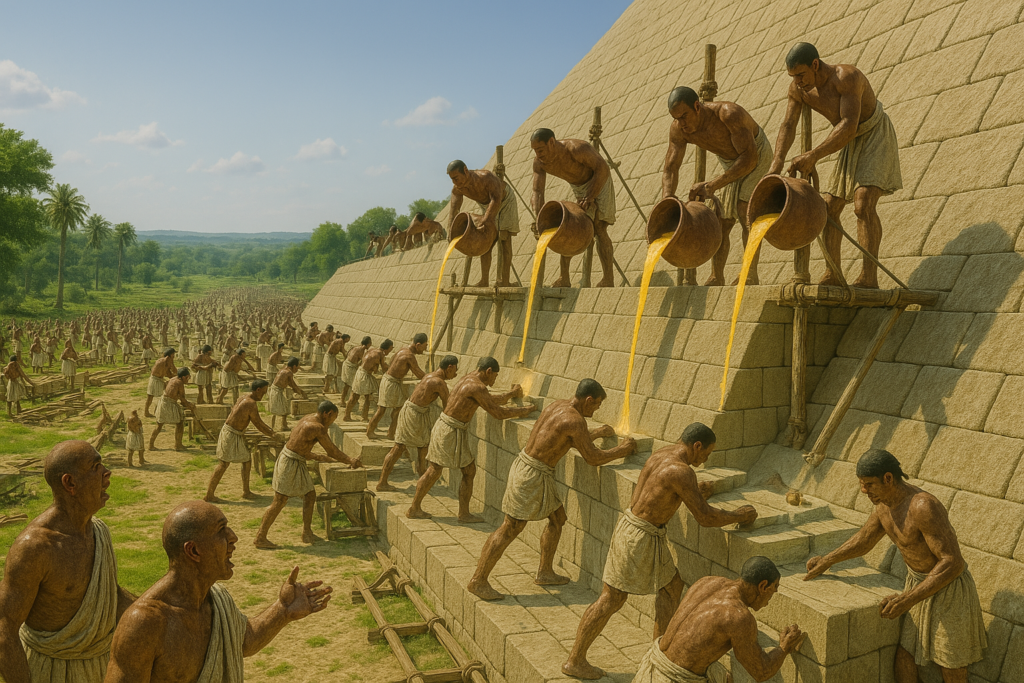
For centuries, the Egyptian pyramids have been the world’s favorite architectural enigma. Massive, flawless, enduring — and built with tools barely more advanced than a spoon and determination, or so we’re told.
The mainstream narrative? Tens of thousands of laborers spent decades dragging 2.3 million multi-ton limestone blocks across the desert, stacking them with impossible precision using sticks, ramps, and brute force. It’s an epic story. It’s also deeply flawed.
Because here’s what no one wants to admit: they didn’t move millions of stones.
They poured them.
The Myth of the Mover
Let’s start with the obvious: the standard theory doesn’t make logistical sense. The Great Pyramid of Giza contains stones weighing anywhere from 2 to 70 tons. The precision of the blocks, the complexity of the internal chambers, and the fact that they’re still standing millennia later defy the tools supposedly used to build them. Copper chisels? Wooden sleds? Sand ramps the size of the pyramid itself that mysteriously vanished without a trace?
No. Just no.
Let’s give our ancestors the credit they deserve. The truth is, these people weren’t primitive brutes with endless time and aching backs. They were smart. Advanced. Maybe more advanced in some ways than we are now. Because they discovered something we forgot:
How to cast stone.
The Geopolymer Revelation
French materials scientist Joseph Davidovits cracked the code decades ago. Studying the limestone blocks of the Great Pyramid under a microscope, he found evidence they weren’t carved — they were man-made geopolymers. In other words: early concrete.
What he discovered:
- Amorphous microstructures not found in natural limestone
- Trapped air bubbles like you’d find in a poured mixture
- High water content inconsistent with quarried rock
- Clay and mineral binding agents suggesting a slurry mix
This wasn’t just a random rock formation. It was an engineered material, chemically bonded, mixed by hand, and poured into place. The ancients had developed a stone-mixing technique we now call geopolymer technology — a low-temperature chemical process that binds silicates and alumina-rich materials into a solid, rock-like mass.
You know what that is? That’s pourable stone.
The Toolmarks That Weren’t There
We’ve long puzzled over how the blocks fit together with no mortar, no gaps, and no margin for error. In fact, some joints are so tight that not even a razor blade fits between them. But here’s the thing:
- There are no consistent tool marks.
- Some stones show internal textures inconsistent with quarrying.
- Corner joints are too tight and too numerous to be manual.
Why? Because they weren’t carved. They were molded, formed, and cured in place.
Picture this: simple wooden molds, maybe lined with cloth or reeds, filled with a gooey limestone slurry. Let it cure under the Egyptian sun, pop the mold, repeat. Boom — block perfection.
That’s not fantasy. That’s concrete logic.
Why It Explains Everything
This theory doesn’t just fill in the blanks — it solves the puzzle.
- Massive blocks? Size doesn’t matter if you’re pouring in place.
- No transport marks? Because they didn’t transport.
- No ramps found? Because they didn’t need them.
- Strange corner joints? Molded that way.
- Blocks too perfect to replicate even today? Because we forgot the recipe.
Even the oddly modern features — sun temple basins shaped like flanges, strange symmetrical stone artifacts — suddenly make sense. They weren’t ritual items. They were parts of a construction system we no longer understand.
So Why Is This Still a Secret?
Because rewriting history is uncomfortable. Academia clings to its narratives. The idea that ancient Egyptians had concrete before the Romans messes up centuries of textbooks, museum exhibits, and PhD theses.
And let’s be real — we’re more comfortable with aliens than the idea that ancient humans were that smart.
But they were. The only mystery left is: how did we forget?
The Final Pour
It’s time to update the history books. The pyramids were not built stone by stone in some epic slave-powered miracle of endurance. They were engineered. Crafted. Poured into place using a technique so efficient, it lasted 4,500 years and still baffles us.
“Mix. Pour. Cure. Repeat.”
That’s how they built the pyramids.
And now, you know.


